Lend-Lease. Northern convoys. Strategic importance
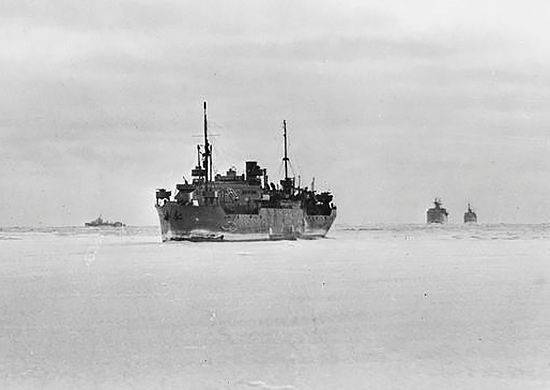
With the beginning of the war against the Soviet Union, the Hitler leadership was counting on the political isolation of our country, but already on July 12, Britain and the USSR signed an agreement on joint actions in the war against Germany. At the September 1941 conference held in Moscow on October 29 in October, representatives of the USSR, Great Britain and the United States decided to provide the Soviet Union with arms and strategic materials and our supplies to the United States and Britain of raw materials for military production.
The system of transferring or leasing weapons, ammunition, vehicles, industrial equipment, oil products, raw materials, food, information and services necessary for warfare to the countries - allies in the anti-Hitler coalition 1941 – 1945 that existed during the war years. Lend-Lease from English lend - to lend and lease - to lease was invented by US President F. Roosevelt, who sought to support the states that were attacked by the German and Japanese aggressors. The Lend-Lease Act was passed by the US Congress 11 in March 1941. Its validity was repeatedly extended and extended not only during the war, but also during the first post-war years. The law earned immediately after its adoption. On 30 June 1945, the Lend-Lease Delivery Agreement was signed by the USA with 35 countries. In response to the armaments and other cargo arriving in the USSR, the Allies received 300 thousand tons of chrome ore, 32 thousand tons of manganese ore, a significant amount of platinum, gold, wood, etc. Russia completed payments to the United States for goods supplied during the war only in 2006.
As soon as it became obvious that cargo from Great Britain and the United States would soon arrive in the Soviet Union, the question immediately arose about the routes of their delivery. The closest and safest route from America to the USSR in the summer and autumn of 1941 was through the Pacific Ocean. But, firstly, from 5 of the largest Soviet Pacific ports, only Vladivostok had a rail connection with the front, and secondly, cargo from Primorye was stuck for weeks on the Trans-Siberian Railway. However, the “Pacific Route” functioned throughout the war, and through it 47% of imported cargo was delivered to the Soviet Union. The air bridge Alaska - Siberia, which was unattainable for the enemy, acted here, along which about 8 thousand planes were delivered to the USSR. Another route ran through the Persian Gulf and Iran. But he was able to start functioning only in the middle of 1942. Subsequently, when all technical and organizational problems were resolved, this route took over 23,8% of all allied supplies. However, this was later, and help was needed in the fall of 1941.
The most appropriate was the third route - through the Norwegian and Barents Seas to Arkhangelsk and Murmansk. Despite the fact that the ships traveled this route in 10-14 days, and the proximity of the northern ports to the center of the country and the front, this route had significant drawbacks. The non-freezing port of Murmansk was only a few tens of kilometers from the front line and therefore was subjected to continuous air strikes. Arkhangelsk, relatively remote from the front line, for several months a year became inaccessible to ships due to freezing of the White Sea. The route itself from the British Isles to the Kola Peninsula passed along the occupied Norwegian coast, where the bases of the German Air Force and Navy were located, and thus it was under continuous influence throughout its entire length fleet и aviation the enemy. Nevertheless, in the period crucial for our country, 1941–1942. the northern direction was most effective.
The organization of convoys and the responsibility for the safety of their passage to our ports and back was assigned to the British Admiralty. In accordance with the organization of the convoy service established in the English fleet, the department of merchant shipping of the admiralty was involved in all matters relating to the formation of convoys and their transition. Convoys were formed in the base of Lough Yu and Scapa Flow in England, Reykjavik and the hall. Fjord in Iceland (in 1944 – 1945 - only Lough Yu). The points of arrival of the convoys and sending them back were Arkhangelsk, Molotovsk (Severodvinsk), Murmansk. Transitions were made in 10 – 14 days. During the freeze-up period, the movement of ships in the White Sea was provided by Soviet icebreakers. The convoy included British transports loaded in various ports, American and other allied transports arriving in England or Reykjavik from the United States. Since 1942, more than half of the ships in the convoys were American. From November 1941 to March 1943 (before transferring part of our ships to the Far East), Soviet transports were also included. The limitations of our merchant fleet and the lack of ships with speeds of 8 – 10 nodes did not allow them to be used on a wider scale.
Initially, the British formed convoys of 6 – 10 ships, sending them from one to three weeks apart. Since March 1942, the number of transports in convoys increased to 16 – 25, and PQ-16, PQ-17 and PQ-18 had respectively 34, 36 and 40 units. From the end of December 1942, the big convoys began to be divided into two groups, each of the 13 – 19 ships. From February 1944 began to send convoys consisting of 30 – 49, and in 1945 - from 24 – 28 transports. The passage of the convoys was carried out along the route England (or Iceland) - about. Jan Mayen - oh. Bear - Arkhangelsk (or Murmansk). Depending on the ice situation in the Greenland and Barents Seas, the route was chosen north of the island. Jan Mayen and Bear (possibly further from enemy bases and airfields in Northern Norway) or to the south of these islands (in winter). The British used circular security vehicles. It included squadron and escort destroyers, corvettes, frigates, sloops, minesweepers and submarine hunters. Each ship was assigned a place in the overall marching order of the convoy. When submarines were detected, separate escort ships left the line and began pursuing, often breaking away from the convoy. In some cases, the convoy fell apart (in stormy weather, with the threat of attack from surface ships).
To protect the convoy from a possible attack by surface ships, a covering squad was assigned. Sometimes it was divided into two groups: the cruiser detachment (close cover) and the long-range (operational) cover, which included battleships, cruisers, and sometimes aircraft carriers. A detachment of operational cover moved parallel to the course of movement of the convoy or deployed on long-range approaches to enemy bases. In the operational zone of the Northern Fleet (east of the meridian 18 °, and then 20 ° east longitude), protection was intensified by Soviet ships and aircraft. In addition, Soviet ships searched for submarines and trawling fairways on the approaches to the Kola Bay and in the throat of the White Sea to Arkhangelsk.
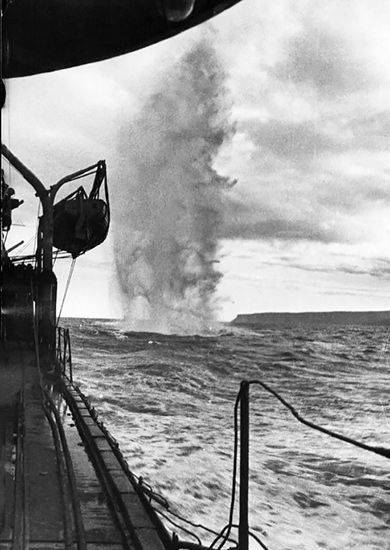
The first convoy from Great Britain to the USSR was 21 August 1941 d. It consisted of English 6 and Danish 1 transport in the protection of 2 destroyers, 4 corvettes and 3 minesweepers. He received the name by the name of the operation for his posting - "Dervish." But later, when the convoys going to the Soviet Union were given the letter designation PQ, the first in the documents began to be called PQ-0. This designation arose completely by accident and was the initials of a British officer who was in charge of the operational management of the admiralty at that time in planning the escort operations to the Soviet Union, Peter Quilin. Reverse convoys were designated QP. From December 1942, the convoys were designated respectively YW and RA and the sequence number, starting with the conventional number - 51.
31 August 1941 The Dervish convoy arrived in Arkhangelsk without a loss and became the real incarnation of the Anglo-Soviet military cooperation. The fact is that, along with trucks, mines, bombs, rubber and wool, 15 disassembled English Hurricane fighters were unloaded onto the moorings of the Arkhangelsk port. Until the end of 1941, 10 convoys were conducted in both directions. The situation prevailing in 1941 on external communications did not cause concern for the fate of external convoys. The German plan "Barbarossa" planned the defeat of the Soviet Union in a fleeting company mainly by ground forces and aviation. Therefore, the German Navy also did not consider the Polar region as an area of possible application of their efforts. The Germans did not take any measures to disrupt external communications and there were no losses in the convoys. 1942 for the northern convoys was in many ways not similar to the previous one, there was an ever-increasing impact of the enemy.
Since A. Hitler did not believe that the German fleet could achieve the decisive goals of the war in the West against Great Britain, he decided to use the core of large surface ships, significant forces of the submarine fleet and aircraft to achieve victory in the East. In order to interrupt sea communications between the Soviet Union and Great Britain, and also to prevent a possible landing of troops to northern Norway, in January – February 1942, the battleship Tirpitz, the heavy cruisers Admiral Scheer, were relocated to the Trondheim region, Lutz "," Hipper ", light cruiser" Cologne ", 5 destroyers and 14 submarines. To ensure these ships, as well as to protect their communications, the Germans concentrated here a significant number of minesweepers, patrol ships, boats and various auxiliary vessels. The number of 5 air fleet of Germany, based in Norway and Finland, increased to the 1942 aircraft by the spring of 500. The first ship on the route of the northern convoys was lost on 7 in January of 1942. It turned out to be the English steamer “Waziristan”, which was part of the convoy РQ-7. The first major operation of the Nazi surface forces against the Allied convoys was carried out in March 1942 (code name "Shportpalas"). The battleship Tirpitz in escorting 8 destroyers and submarines went to intercept the QP-3 convoy. As a result, the timber carrier Izhora, lagging behind the convoy, was sunk.
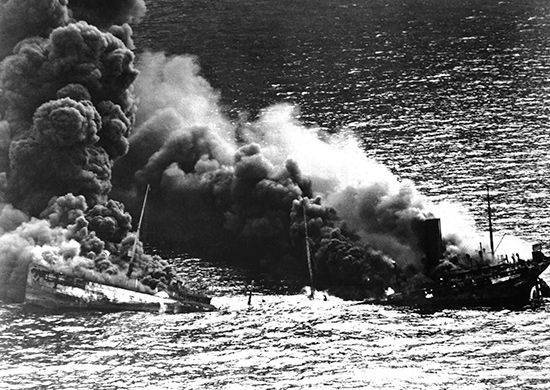
In March, 1942, the German aircraft began to strike at convoys at the sea crossing, and in April began to massive raids on Murmansk. As a result of air attacks, the convoy PQ-13, which arrived in Murmansk on March 30, lost the 4 ship and the escort ship.
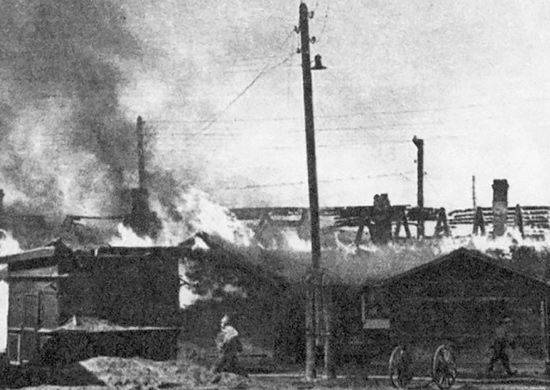
If before this time the Northern Fleet ensured the movement of external convoys in the order of daily combat activity, then from the PQ-13 convoy to provide two regular convoys (coming to the USSR and leaving to the UK), the fleet began to conduct operations in which almost all the forces of the fleet participated: destroyers and patrol ships reinforced the direct guard of the convoy; the aircraft bombed airfields and bases, covered the convoys as they approached at a distance of 150 – 200 miles to the coast and carried out air defense of the bases and stops of the ships; minesweepers, patrol ships and boats maintained coastal areas and raids safe from mines and submarines. All these forces were deployed on the eastern leg of the convoys up to 1000 miles. But the situation became more complicated from 75 ships in the 4 convoys that left the UK, Iceland and the Soviet Union in April 9 was sunk: QР-10 - 4 vessel, РQ-14 - 1 vessel, РQ-15 - 3 vessel.
At the end of May, the PQ-16 convoy lost 6 transports due to air strikes. May 30 in an air battle over this convoy, shooting down three U-88, killed one of the famous pilots of the Great Patriotic War 1941 – 1945. commander of the air regiment Hero of the Soviet Union Lieutenant Colonel B.F. Safonov (27 in May, he was presented by the Commander-in-Chief of the Navy to be awarded the second Gold Star medal). In general, the situation around the northern convoys, in the summer of 1942, can be defined as critical. A peculiar watershed, the deepest crisis of the northern convoys was РQ-17, which became the most tragic convoy of the Second World War.
27 June 1942 The RQ-17 left the Hvalfjord in Iceland as part of the 36 transports (including the Soviet tankers Azerbaijan and Donbass) and 3 rescue vessels. Two vehicles soon returned due to damage. The escort included up to 20 English ships (destroyers, corvettes, air defense ships and minesweepers). To the south of the convoy was a close-cover squad of 4 cruisers and 2 destroyers. In the eastern part of the Norwegian Sea, the long-range squadron was maneuvered as part of 2 battleships, 2 cruisers and the aircraft carrier Victories with cover from 12 destroyers. By June 29, the K-2, K-21, K-22, U-403 and nine British submarines were deployed off the coast of Northern Norway.
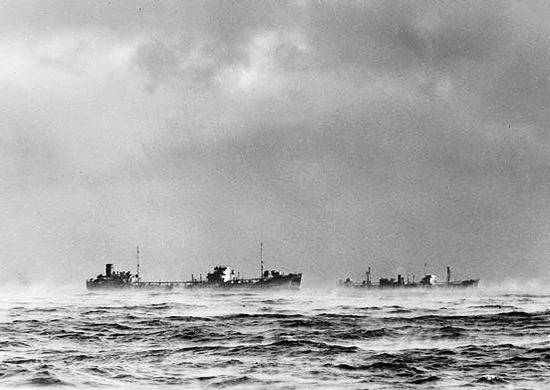
On the airfields of the Kola Peninsula were prepared for the actions of 116 aircraft. Thus, the provision of the convoy with surface forces was sufficiently reliable in the event of a meeting with the enemy squadron. To defeat the convoy, the fascist German command prepared 108 bombers, 30 dive bombers, and 57 torpedo bombers. 11 submarines were to act against the convoy. Two groups of surface ships were in Trondheim (the battleship Tirpitz, the heavy cruiser Admiral Hipper, the 4 destroyer), and Narvik (the heavy cruisers Admiral Scheer, Lutz, 6 destroyers). The use of large surface ships to attack convoys A. Hitler allowed only if there were no British aircraft carriers nearby.
On July 1, enemy aerial reconnaissance detected a PQ-17 convoy in the Norwegian Sea. During the first 4-x days, the convoy successfully repelled attacks from aircraft and submarines, although 3 vehicles were sunk. At about the same time, a detachment of enemy ships, while deploying from Narvik to Altenfjord, hit the stones, as a result of which the heavy cruiser Lutz and 3 destroyer were damaged. In the morning of July 4, the Allied Command became aware of the upcoming deployment of an enemy surface force, including the Tirpicz battleship. The first sea lord Admiral D. Pound decided to disperse the convoy. In 22 h 30 mines 4 July, on the orders of the British Admiralty, the direct-escort destroyers and near-cover ships moved west to join the long-range unit. The transports were ordered to disperse and independently follow to the Soviet ports.
5 July around 11 hours a German squadron led by the battleship Tirpitz (12 ships) went to sea. Soon, in the area north of Gammerfest, the submarine K-21 (captain 2 of rank N. Lunin) found her, attacked the battleship with torpedoes and reported it to the command. On the same day, the squadron was discovered by an airplane and a submarine of the British, who also reported on its appearance. Having intercepted these radiograms, the German command ordered the squadron to return to the Altenfjord. The ships left without cover in the conditions of the polar day became easy prey for enemy aircraft and submarines. From 5 to 10 in July, 20 transports and a rescue ship were sunk in the northeastern part of the Barents Sea. Those who escaped in the bays and bays of Novaya Zemlya and whose crews showed heroism in the struggle for the survivability of their vessels were rescued from the convoy.
The Northern Fleet required vigorous and extensive measures to search for and assist in transport. On July 28, the last transport of the PQ-17 convoy, Winston Salem, arrived in Arkhangelsk. Of the 36 transports of the PQ-17 convoy, two vessels returned to Iceland, 11 reached Murmansk and Arkhangelsk, 23 were sunk. 153 people were killed. Soviet ships and ships saved about 300 English and Soviet sailors. Together with transports, 3350 cars were lost, 430 tanks, 210 aircraft and about 100 thousand tons of cargo.
After the catastrophe with the PQ-17 escort, the British government refused to send convoys to the Soviet Union. Only under pressure from the Soviet government in early September, the convoy РQ-18 left Iceland for the Soviet Union. It consisted of 40 ships. The convoy provided more 50 escort ships. For the first time, a convoy aircraft carrier with 15 aircraft on board was included in the escort, which caused significant damage to the enemy during a raid by enemy aircraft. The conditions for the transfer of the PQ-18 convoy were in many ways similar to the previous one, but this time the escort ships and all Allied support forces took the fight. The convoy attacked 17 submarines and more 330 aircraft. In total, German aviation managed to sink 18 transports from the PQ-10 convoy, submarines 3 transports. In the zone of the Northern Fleet only 1 transport was sunk. The German fleet and aircraft received due repulse - 4 boats were sunk and 41 aircraft were shot down.
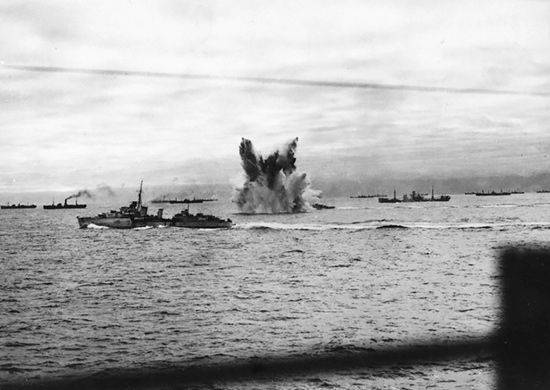
During the passage of the PQ-18 and QP-14 convoys, losses on both sides were great, but it became clear that with strong security and sufficient measures to ensure the Germans would not be able to interrupt communication routes between the Soviet Union and Great Britain in the North. However, the Allies again refused to send convoys before the polar night. In October - November 1942, at the suggestion of the Soviet command, the system of movement of single transports was tested (“movement by drop”). The Allies considered sailing single vessels ineffective, and was later abandoned.
With the onset of the polar night, winter stormy weather, the movement of convoys to the Soviet Union resumed. The first convoy in mid-December passed unnoticed by the enemy. The second was attacked by two heavy cruisers and 6 destroyers. To transport they did not make their way. Both sides lost a destroyer, and there were no losses in transports. This failure was one of the reasons why A. Hitler decided to replace the German fleet commander, Grand Admiral E. Raeder, who replaced the actions of large surface forces with Admiral K. Dönitz, who gave priority to submarine forces. In January and February, 1943 in the North passed several convoys with strong escort. From February to November 1943, not a single convoy arrived at the Soviet ports - PQ-17 syndrome was too large. Given that during the whole winter the convoys going to the Soviet Union did not lose a single transport. True, reverse convoys lost 6 ships sunk by German submarines. But this is 6 from 83 transports.
After the British ships sank in December 1943 of the battleship Scharnhorst in the Barents Sea, the German command refused to engage large surface ships to fight the convoys. The activity of the German fleet in the North Atlantic has sharply decreased. The main opponents of the convoys in the North were submarines, whose number has increased.
Since February 1944, the English Admiralty has returned to the formation of large convoys for the USSR with 1 – 3 escort aircraft carriers in guard. The defense of the convoys increased the proportion of ships that conducted a preliminary search. In the anti-submarine defense system, the role of naval aviation has increased significantly. During 1944, on account of lend-lease deliveries, the Northern Fleet received a large hunter 21, torpedo boats 44, 31 sentry boat, minesweeper from the USA 34, equipped with acoustic and electromagnetic trawls, had sonar stations and Hedgehog jet bombs, and Hedgehog jet bombs, and qualitatively changed the fleet trawl forces. In addition, in accordance with the decisions of the Tehran Conference on the future division of the Italian fleet, in August 1944, the Soviet crews brought to the North the battleship Arkhangelsk (Royal Sovereign), 9 destroyers of the type Hot (Richmond type), The 4 submarines of the Ursula ("B") type are from Great Britain, the cruiser Murmansk (Milwaukee) are from the United States. The enemy repeatedly tried to influence the external communications of the allies, but did not have much success. Before 5, the 8 convoys from the 275 transports passed in both directions, losing just the 4 transport and two destroyers. For the entire year of the 1944, the Germans managed to sink the 6 transports and the 3 escort ship, losing 13 submarines.
External convoys continued to move between British and Soviet ports until 28 in May 1945. The final phase of the campaign is characterized by increased activity of enemy submarines. They began to operate in areas where evading them was almost impossible - on the approaches to the Kola Bay and the areas adjacent to it. When crossing the Allied convoys, the number of enemy submarines in these areas increased to 10 – 12. All of them were upgraded and equipped with a Snorkel device, which ensured the operation of diesel engines and the charging of batteries at the periscope depth, had more advanced radar and sonar stations and received self-guided acoustic torpedoes. All this forced the command of the Northern Fleet to allocate additional anti-submarine forces along the route of the convoys. In total, to ensure the safety of external convoys, fleet ships in 1945 sailed 108 times, anti-submarine aviation made 607 sorties. When escorting external convoys, the Allies lost 5 transports and 5 escort ships. The Northern Fleet lost the destroyer Active, torpedoed on January 16 by an enemy submarine. In 1945, 5 convoys consisting of 136 transports arrived from England to the northern ports of the USSR; the same number of convoys went back - 141 transport.
Postings of convoys have preserved many examples of mutual assistance and mutual assistance of British and Soviet sailors and pilots. A number of them were awarded orders of the USSR and Great Britain. Allied Arctic convoys have become one of the clearest examples of the combat engagement of the Allied fleets in World War II. Thus, the heroic feat was accomplished by the crew of the Soviet “Old Bolshevik” timber carrier, which was marching as a part of the PQ-16 convoy. The ship, loaded with military equipment, ammunition and gasoline, was attacked and set on fire by fascist aircraft. Soviet sailors rejected the proposal of the English command to switch to other transports. The convoy left, leaving the burning timber. For eight hours the crew of the ship that lost the course beat off the attacks of the enemy's aircraft, fought with water, fire, and emerged victorious. Having eliminated the damage, the Soviet sailors delivered the cargo necessary for the front to Murmansk. For the courage shown, many crew members were awarded orders and medals, and the captain of the vessel I.I. Afanasyev and B.I. Akkazenok was awarded the title Hero of the Soviet Union.
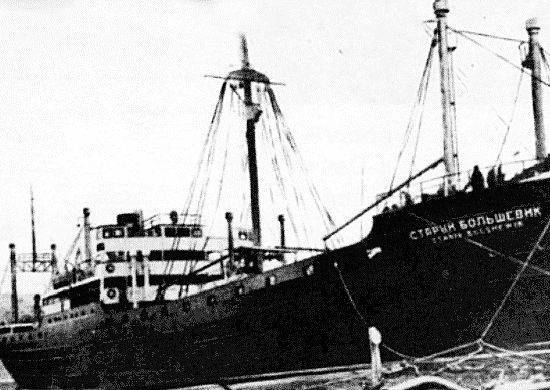
В history Northern convoys entered a lot of heroic pages. The most obvious of these is the tragedy of PQ-17. A small Canadian paramilitary trawler "Ayrshire" under the command of Lieutenant L. Gradwell, after an order to disperse, took 3 transport under his guard and led them into the ice. Having camouflaged ships under icebergs, uncovered and putting in alert the guns of transported tanks, the group arrived without loss to Novaya Zemlya, and from there to Arkhangelsk. Captain of the tanker "Azerbaijan" V.N. Izotov refused to transfer from the burning ship to the rescue ships that had arrived, the crew of the tanker, consisting mainly of women, managed not only to locate the fire, and soon extinguish it. The fuel was delivered to the destination. Part of the crew of the Soviet steamer “Kiev” who was killed in April 1942 (convoy QP-10) was returning to Homeland, on English transport, “Empire Byron”. When the ship was torpedoed by a German submarine, the British and Soviet sailors were in the same boat. Skillful actions of the English foreman V.Pras and the Soviet ship's doctor A.I. Leskina slept their lives.
In total, during the war years, 40 convoys consisting of 811 ships passed to the Soviet Union with Arctic waters. Of these, 58 transports were destroyed by the enemy at the junction and 33 returned to the ports of departure. In the opposite direction, from the Soviet Union to the ports of Great Britain and Iceland, as part of the 35 convoys, 715 ships departed, from which 29 were sunk at the crossing, and 8 returned. Thus, in both directions during the war years in the northern convoys, the entire route passed 1398 ships, the losses amounted to 87 ships, 69 of which fell on the most tragic 1942.
The northern route played an extremely important role in the delivery of strategic cargo for the USSR at the first stage of the war. The risk was justified by the speed at which weapons were delivered to the Soviet front in the most difficult period for the country. Until July 1942 with northern convoys sent 964 thousand tons weapons, materials and food - 61% of all goods imported into the USSR from abroad. 2314 tanks, 1550 tank tanks, 1903 aircraft and others were delivered via the northern route. From July 1942 to the end of 1943, the role of the northern route began to decline, the total share of supplies to the USSR decreased from 61% to 16%. Although still almost half of all weapons imported into the country (tanks, airplanes, etc.) were delivered by the northern convoys. At the final stage of the war, due to the gradual closure of the “Iranian corridor”, its role again increased. In 1944 – 1945 according to it, over 2,2 mln. tons or 22% of all cargoes were delivered to the country. Over the years of the war, the northern route delivered 36% of all military cargo.
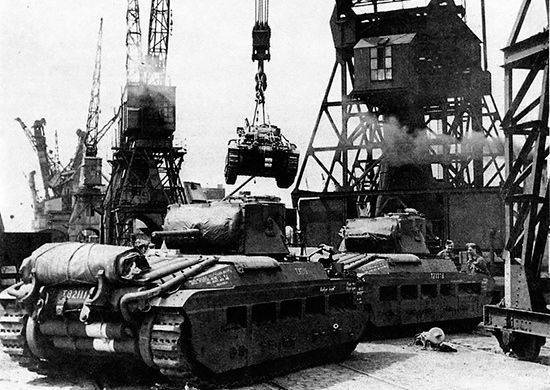
Mustang attack aircraft on board transport
List of Allied Arctic Convoys
1941
To the USSR From the USSR
"Dervish" - PQ-0 from Iceland on August 21
to Arkhangelsk on August 31 QP-1 from Arkhangelsk on September 28
in Scapa Flow10 October
PQ-1 from Iceland 29 September
to Arkhangelsk on October 11 QP-2 from Arkhangelsk on November 3
on the Orkney Islands November 17
PQ-2 from Liverpool on 13 October
to Arkhangelsk on October 30 QP-3 from Arkhangelsk on November 27
scattered on the way, arrived 3 December
PQ-3 from Iceland 9 November
to Arkhangelsk on November 22 QP-4 from Arkhangelsk on December 29
scattered on the way, arrived 9 January 1942
PQ-4 from Iceland 17 November
to Arkhangelsk 28 November
PQ-5 from Iceland 27 November
to Arkhangelsk 13 December
PQ-6 from Iceland on 8 December
to Murmansk 20 December
1942
PQ-7A from Iceland 26 December 1941
to Murmansk on January 12 QP-5 from Murmansk on January 13
scattered on the way, arrived 19 January
PQ-7B from Iceland on 31 December
to Murmansk on January 11 QP-6 from Murmansk on January 24
scattered on the way, arrived 28 January
PQ-8 from Iceland on January 8
to Arkhangelsk on January 17 QP-7 from Murmansk on February 12
scattered on the way, arrived 15 February
Combined
PQ-9s and PQ-10s from Iceland on 1 February
to Murmansk on February 10 QP-8 from Murmansk on March 1
in Reykjavik 11 March
PQ-11 from Scotland on 14 February
to Murmansk on February 22 QP-9 from Kola Bay on March 21
in Reykjavik 3 April
PQ-12 from Reykjavik on March 1
to Murmansk on March 12 QP-10 from Kola Bay on April 10
in Reykjavik 21 April
PQ-13
from Scotland 20 March
to Murmansk 31 March
QP-11 from Murmansk on 28 April
in Reykjavik 7 May
PQ-14s from Scotland 26 March
to Murmansk on April 19 QP-12 from Kola Bay on May 21
in Reykjavik 29 May
PQ-15s from Scotland on 10 April
to Murmansk on May 5 QP-13 from Arkhangelsk on June 26
in Reykjavik 7 July
PQ-16 from Reykjavik on 21 May
to Murmansk on May 30 QP-14 from Arkhangelsk on September 13
to Scotland 26 September
PQ-17 from Reykjavik on 27 June
scattered on the way
arrived July 11 QP-15 from Kola Bay November 17
to Scotland 30 november
PQ-18s from Scotland on 2 September
to Arkhangelsk 21 September
JW-51A from Liverpool on 15 December
to Kola Bay on December 25 RA-51 from Kola Bay on December 30
to Scotland 11 January 1943
JW-51B from Liverpool on 22 December
to Kola Bay 4 January 1943
FB independent vessels without escort "drop by drop"
1943
JW-52 from Liverpool on 17 January
to Kola Bay on January 27 RA-52 from Kola Bay on January 29
to Scotland February 9
JW-53 from Liverpool on 15 February
to Kola Bay on February 27 RA-53 from Kola Bay on March 1
to Scotland 14 March
JW-54A from Liverpool on 15 November
to Kola Bay on November 24 RA-54A from Kola Bay on November 1
to Scotland 14 november
JW-54B from Liverpool on 22 November
to Arkhangelsk on December 3 RA-54B from Arkhangelsk on November 26
to Scotland 9 December
JW-55A from Liverpool 12 December
to Arkhangelsk on December 22 RA-55A from Kola Bay on December 22
to Scotland 1 January 1944
JW-55B from Liverpool on 20 December
to Arkhangelsk on December 30 RA-55B from Kola Bay on December 31
to Scotland 8 January 1944
1944
JW-56A from Liverpool on 12 January
to Arkhangelsk on January 28 RA-56 from Kola Bay on February 3
to Scotland February 11
JW-56B from Liverpool on 22 January
to Kola Bay on February 1 RA-57 from Kola Bay on March 2
to Scotland 10 March
JW-57 from Liverpool on 20 February
to Kola Bay on February 28 RA-58 from Kola Bay on April 7
to Scotland 14 April
JW-58 from Liverpool on 27 March
to Kola Bay April 4 RA-59 from Kola Bay April 28
to Scotland 6 May
JW-59 from Liverpool on 15 August
to Kola Bay on August 25 RA-59A from Kola Bay on August 28
to Scotland 5 September
JW-60 from Liverpool on 15 September
to Kola Bay on September 23 RA-60 from Kola Bay on September 28
to Scotland 5 October
JW-61 from Liverpool on 20 October
to Kola Bay on October 28 RA-61 from Kola Bay on November 2
to Scotland 9 november
JW-61A from Liverpool on 31 October
to Murmansk on November 6 RA-61A from Kola Bay on November 11
to Scotland 17 november
JW-62 from Scotland on 29 November
to Kola Bay on November 7 RA-62 from Kola Bay on December 10
to Scotland 19 December
1945
JW-63
from Scotland 30 December
to Kola Bay on January 8, 1945 RA-63 from Kola Bay on January 11
to Scotland 21 January
JW-64 from Scotland on 3 February
to Kola Bay on February 15 RA-64 from Kola Bay on February 17
to Scotland February 28
JW-65 from Scotland 11 March
to Kola Bay on March 21 RA-65 from Kola Bay on March 23
to Scotland 1 April
JW-66 from Scotland 16 April
to Kola Bay April 25 RA-66 from Kola Bay April 29
to Scotland 8 May
JW-67 from Scotland 12 May
to Kola Bay on May 20 RA-67 from Kola Bay on May 23
to Scotland 30 May
Information